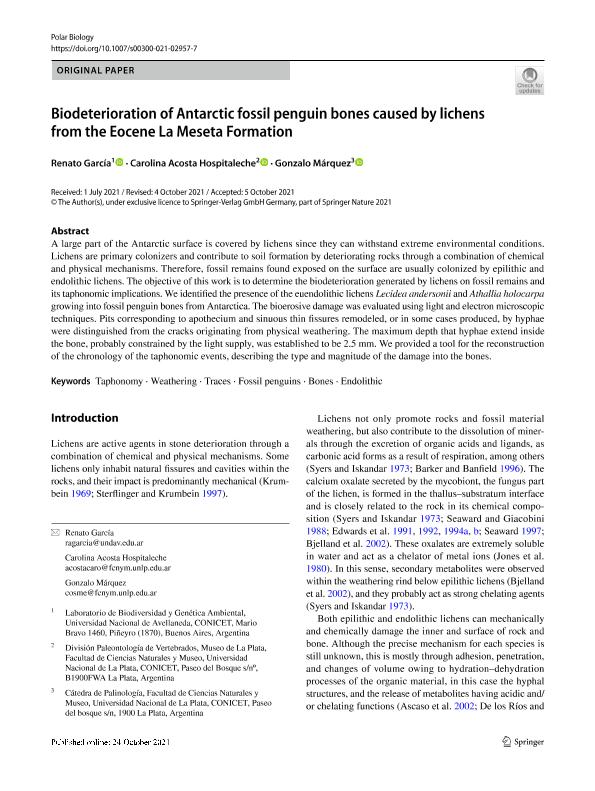Mostrar el registro sencillo del ítem
dc.contributor.author
García, Renato Andrés

dc.contributor.author
Acosta Hospitaleche, Carolina Ileana Alicia

dc.contributor.author
Marquez, Gonzalo Javier

dc.date.available
2021-12-15T13:31:19Z
dc.date.issued
2021-10
dc.identifier.citation
García, Renato Andrés; Acosta Hospitaleche, Carolina Ileana Alicia; Marquez, Gonzalo Javier; Biodeterioration of Antarctic fossil penguin bones caused by lichens from the Eocene La Meseta Formation; Springer; Polar Biology; 44; 12; 10-2021; 2243-2254
dc.identifier.issn
0722-4060
dc.identifier.uri
http://hdl.handle.net/11336/148783
dc.description.abstract
A large part of the Antarctic surface is covered by lichens since they can withstand extreme environmental conditions. Lichens are primary colonizers and contribute to soil formation by deteriorating rocks through a combination of chemical and physical mechanisms. Therefore, fossil remains found exposed on the surface are usually colonized by epilithic and endolithic lichens. The objective of this work is to determine the biodeterioration generated by lichens on fossil remains and its taphonomic implications. We identified the presence of the euendolithic lichens Lecidea andersonii and Athallia holocarpa growing into fossil penguin bones from Antarctica. The bioerosive damage was evaluated using light and electron microscopic techniques. Pits corresponding to apothecium and sinuous thin fissures remodeled, or in some cases produced, by hyphae were distinguished from the cracks originating from physical weathering. The maximum depth that hyphae extend inside the bone, probably constrained by the light supply, was established to be 2.5 mm. We provided a tool for the reconstruction of the chronology of the taphonomic events, describing the type and magnitude of the damage into the bones.
dc.format
application/pdf
dc.language.iso
eng
dc.publisher
Springer

dc.rights
info:eu-repo/semantics/openAccess
dc.rights.uri
https://creativecommons.org/licenses/by-nc-sa/2.5/ar/
dc.subject
BONES
dc.subject
ENDOLITHIC
dc.subject
FOSSIL PENGUINS
dc.subject
TAPHONOMY
dc.subject
TRACES
dc.subject
WEATHERING
dc.subject.classification
Paleontología

dc.subject.classification
Ciencias de la Tierra y relacionadas con el Medio Ambiente

dc.subject.classification
CIENCIAS NATURALES Y EXACTAS

dc.title
Biodeterioration of Antarctic fossil penguin bones caused by lichens from the Eocene La Meseta Formation
dc.type
info:eu-repo/semantics/article
dc.type
info:ar-repo/semantics/artículo
dc.type
info:eu-repo/semantics/publishedVersion
dc.date.updated
2021-12-13T20:42:08Z
dc.journal.volume
44
dc.journal.number
12
dc.journal.pagination
2243-2254
dc.journal.pais
Alemania

dc.description.fil
Fil: García, Renato Andrés. Universidad Nacional de Avellaneda; Argentina. Consejo Nacional de Investigaciones Científicas y Técnicas; Argentina
dc.description.fil
Fil: Acosta Hospitaleche, Carolina Ileana Alicia. Consejo Nacional de Investigaciones Científicas y Técnicas. Centro Científico Tecnológico Conicet - La Plata; Argentina. Universidad Nacional de La Plata. Facultad de Ciencias Naturales y Museo. División Paleontología Vertebrados; Argentina
dc.description.fil
Fil: Marquez, Gonzalo Javier. Consejo Nacional de Investigaciones Científicas y Técnicas. Centro Científico Tecnológico Conicet - La Plata; Argentina. Universidad Nacional de La Plata. Facultad de Ciencias Naturales y Museo. Cátedra de Palinología; Argentina
dc.journal.title
Polar Biology

dc.relation.alternativeid
info:eu-repo/semantics/altIdentifier/url/https://link.springer.com/10.1007/s00300-021-02957-7
dc.relation.alternativeid
info:eu-repo/semantics/altIdentifier/doi/http://dx.doi.org/10.1007/s00300-021-02957-7
Archivos asociados
